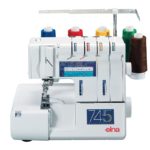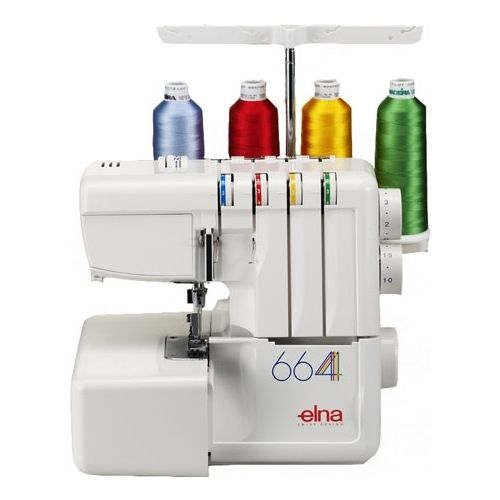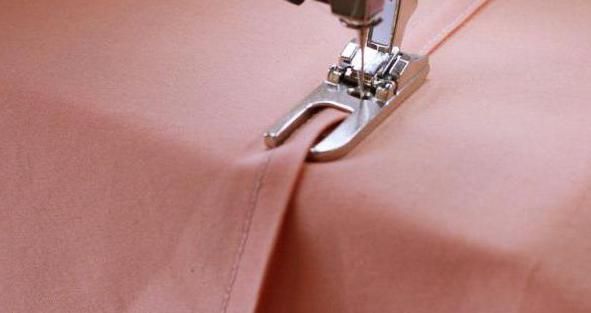How to choose an overlocker
 An overlocker is a compact sewing machine designed for finishing the edges of fabric with a neat elastic seam. This is especially convenient when working with bulk or knitted materials. Items with seams sewn using an overlocker take on a beautiful finished look.
An overlocker is a compact sewing machine designed for finishing the edges of fabric with a neat elastic seam. This is especially convenient when working with bulk or knitted materials. Items with seams sewn using an overlocker take on a beautiful finished look.
The content of the article
How to choose an overlocker for your home
An overlocker does not replace a sewing machine, it only complements its capabilities. Therefore, at home, a seamstress can use a zigzag stitch, which is available on conventional models, to sew seams. Of course, the stitching doesn’t look very neat, but the view from the inside doesn’t bother anyone. When you often have to work with capricious stretch or knitted fabrics, you can no longer do without professional equipment. Seams made using an overlocker are of good quality and do not stretch delicate fabrics. These are the main advantages of all types of overlockers.
There is a wide range of different models of overlockers on the market, both simple and professional. Making the right choice is not an easy task. To do this, it is important to first determine the purpose and purpose of the purchase.
Simple economy class models are designed for sewing light and medium-sized fabrics.If you have to work with expensive and very thin fabrics, require complex seams and many other functions, then you should pay attention to the universal carpet model. Manufacturers provide clear recommendations for operating the equipment in the instructions.
Important! When choosing a household overlocker, you need to take into account the design features of the main models and their technical capabilities.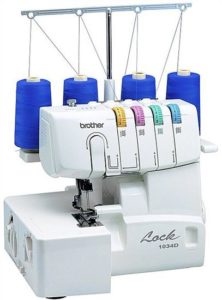
Loopers
Loopers perform the functions of a shuttle in an overlocker and are responsible for the formation of seams, intertwining the threads as the needle moves. In household overlockers, there are often two of them - lower and upper. Despite some differences in the design of loopers, machines from different manufacturers still have in common the ability to freely access them if the threads break.
Three-thread loopers are installed on mid-price overlockers. This type of stitch can be used to overcast the edges of the product and immediately sew it together. Often used when sewing knitted clothing. By tightening the lower looper tension and loosening the needle thread, the Flatlock stitch can be adjusted on these models.
The four-thread looper simultaneously sews and overcasts knitted fabrics. This creates a strong elastic seam. Many models have the ability to work with three threads by turning off one needle. Ideal for working from home. The most common option.
Five-strand models have three lower and two upper loopers with a large stitch width.
Important! The cost of an overlocker increases with the number of threads and loopers, so you need to choose a machine according to your needs.
Refilling method
Proper threading is an important point when using an overcasting machine.If in household overlockers the number of working threads is from three to five, then in industrial models their number reaches 12. The attached instructions contain detailed diagrams of step-by-step threading, drawn in different colors, there are diagrams directly under the overlocker lid.
The unusual design of the overlocker seems complicated at first, and changing threads is extremely difficult. After all, each thread passes through a series of guides before entering the loopers and needles. The lower looper is especially difficult to thread. Having gained experience, all seamstresses do this quickly and easily. If the procedure remains painful, there are ways to make it easier.
- Purchase a model with automatic threading function. This will cost more, but will make refueling the machine easier. Professional seamstresses appreciate this feature for saving working time.
- Many seamstresses have adapted to cutting off the threads near the working spool and tying it to a new thread. Then it remains to pull the thread with the knot through all the holes.
- When choosing sewing equipment, you should pay attention to how clearly all the loopers are visible, which will facilitate the threading process.
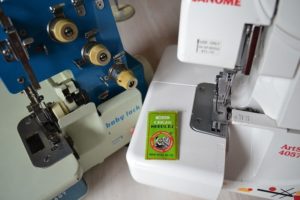
Power
For work at home, household overlockers with low powers of 75-100 W, designed for light loads, are suitable. They can be easily reconfigured with one turn of the lever and have up to 12 lines.
Industrial types are fast, but only perform a certain type of stitching. Designed to work full time. Typically, for stability, such models come complete with a steel table, which is reflected in the cost, and are equipped with a motor with a power of over 250 W.
If a seamstress works from home and sews entire batches of clothes, then you need to think about buying a powerful overlocker.
Tension adjustment
The quality of complex overlock seams and their elasticity depend on the tension of the upper and lower threads. The tension adjusters look different on different models.
There are household machines with manual tension adjustment, and experienced seamstresses quickly adapt to setting the desired settings. Modern computer-controlled models have automatic settings. This is a good option for those who do not want to constantly reconfigure the machine. The computer itself regulates the thread tension depending on the type of seams.
Stitches
There should be five types of stitches that are often used when sewing clothes:
- double thread chain;
- three-thread overlock;
- wide and narrow Flatlock seam;
- four-strand strengthening;
- three-thread rolled hem stitch (roller).
The stitch width is determined by the pitch regulator. It can be used to seal the seam or vice versa. Overlock stitch width varies from 1 to 16 mm. This is important when sewing clothes in different styles, when creating various decorative stitches. The shorter the stitches, the higher the strength of the finished seams. Minimum lengths are from 1 to 2 mm.
The speed of household overlockers is up to 1500 stitches per minute. This is enough for seamstresses of any qualification.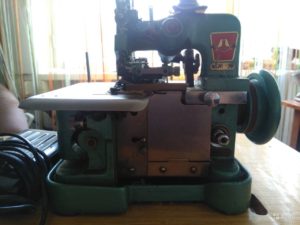
Adjusting the Presser Foot
The presser foot function makes it possible to work with fabrics of different thicknesses, which expands the range of processed products. It can be satin, silk, knitwear, wool. In this case, the foot is raised to a height of 4 mm. There are models adapted to overcast thick edges of rugs and carpets - height 2.5 cm.
The best option would be an overlocker with continuously adjustable presser foot.
Additional features
- differential conveyor for pulling elastic fabric and creating folds;
- convector - a metal bracket on the upper looper for obtaining different types of stitches;
- removable sleeve platform for working with narrow parts;
- trash collection compartment - allows you to keep your workplace clean;
- upper and lower knives for trimming fabric edges;
- needles, the number of which affects the type of seams;
- illumination of the working area with lamps or LEDs.
These items are not required for every machine. The instructions for use indicate all the functions of the overlocker. When choosing a machine, you need to check its working condition on site.
Important! Conscientious manufacturers additionally complete the machines with all spare parts, confirming their serious approach to production and quality of equipment.
If necessary, seamstresses can always buy various devices to make sewing easier.
Which overlocker is better to choose?
When purchasing sewing equipment, you need to pay attention to models with high reliability from well-established manufacturers. You can buy a high-quality overlocker in a regular store or online. Each method has its own advantages: you can test the car in the store, and read customer reviews on online store websites and ask questions to the administrator.
Beginning seamstress
Beginning seamstresses are not recommended to purchase expensive equipment. It will not pay off and will be difficult to master due to lack of experience. A three-thread overlocker with a power of 100 W is perfect.
For those who want to seriously engage in handicrafts or make sewing and repairing clothes a source of permanent income, it is better to buy a four-thread model with a removable platform-sleeve. It is advisable to have a conveyor belt and a mini-computer, which will greatly facilitate the work process.
Important! Recommended models: Family 244D, New Home NH7920 or Singer T80D, Osinka. They have proven themselves to be excellent.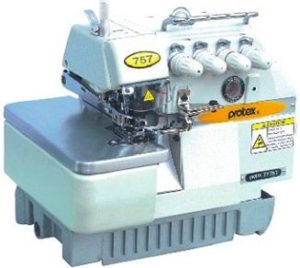
For an experienced master
When a craftswoman works at home to order, the quality of tailoring plays an important role. Professional pride does not allow us to process things poorly and take money at the same time.
Experienced craftsmen cannot imagine their work without an overlocker - this device greatly facilitates the difficult work of a seamstress and is indispensable when sewing a variety of things. For long-term work, you need machines with great functionality. This includes processing of the neckline, pockets, armholes, hemming of the bottom and sleeves. And also sewing on elastic bands, ribbons, buttons, finishing parts, which significantly saves the time of making things.
Having chosen an overlocker model, you need to play it safe and immediately buy spare parts for it if they are not included in the kit. Perhaps, over time, such parts will no longer be on sale.
For experienced craftsmen, the best purchase will be a professional carpet locker. This is an improved overlock model designed for overcasting of varying degrees of complexity and other types of stitches.
Now the most popular, time-tested brands of overlockers are Janome, Minerva, Juki, Toyota, Bernina. The Brother model, designed for various loads, stands out for its good price-quality ratio. Products from well-known manufacturers are a guarantee of quality.
Experienced seamstresses know that to extend the life of any sewing machine, it must be carefully looked after. This includes regular cleaning, removing scraps of thread and fabric with a special brush, and lubricating working units in all accessible places. With careful care, the overlocker will last a long time without breaking.


